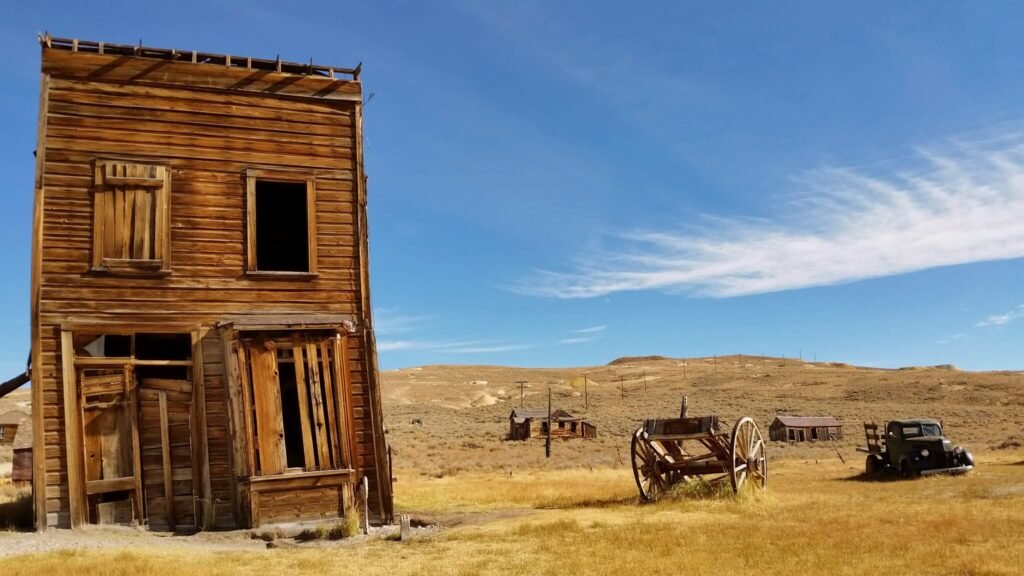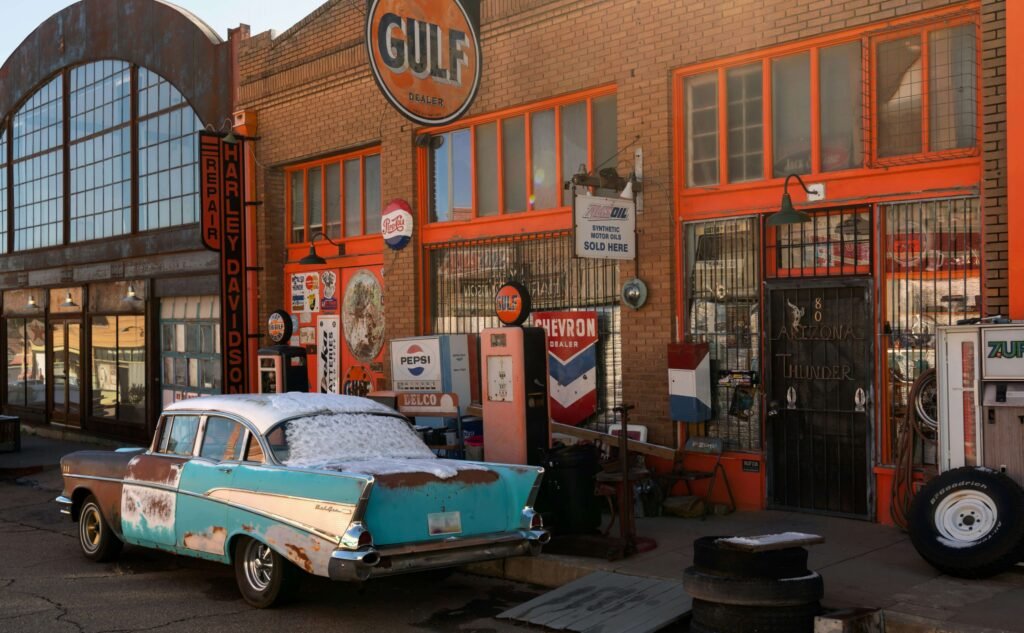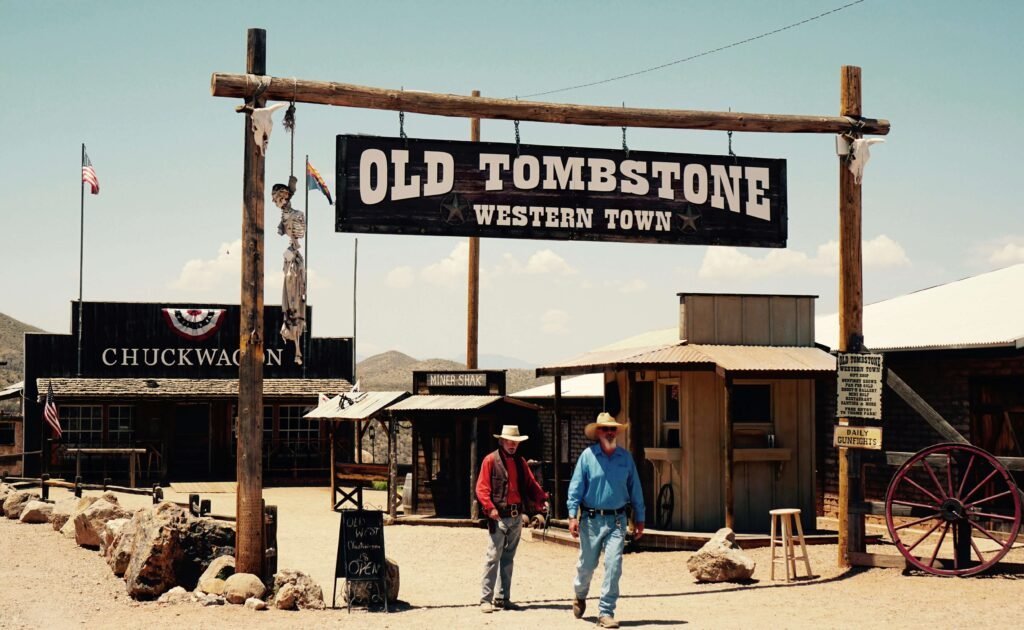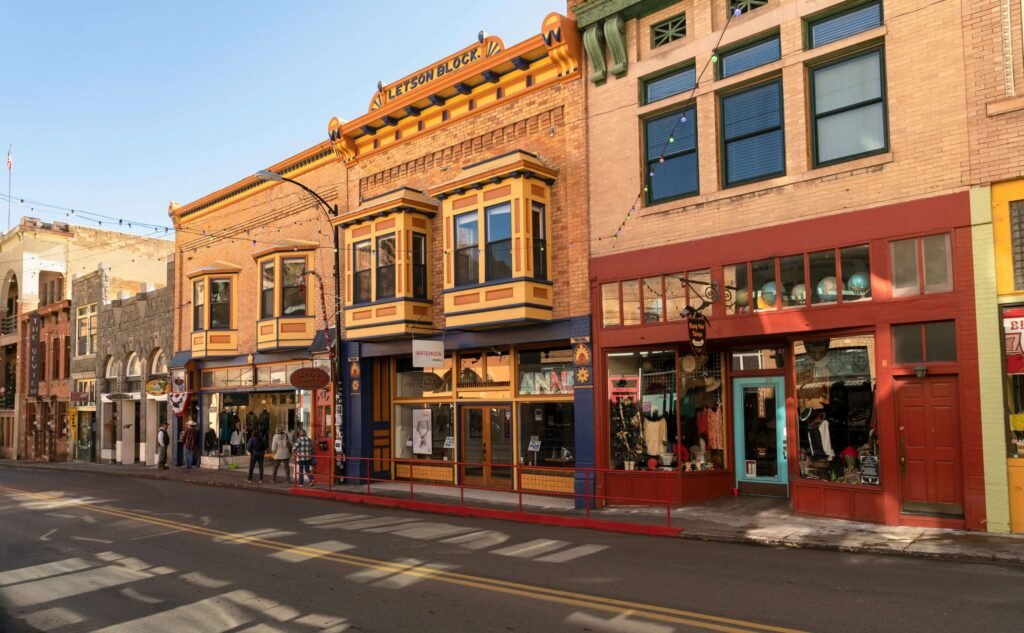Step into the untamed spirit of the Wild West with me as we uncover the hidden gems of Arizona’s frontier towns. Living in this rugged landscape myself, I’ve had the privilege of exploring the real-life remnants of the Wild West on day trips and long weekend drives. From the dusty streets of historic saloons to the sprawling vistas that stretch as far as the eye can see, each town holds a unique charm and a story waiting to be discovered.
Join me as we delve into the rich history, stunning scenery, and authentic experiences that make Arizona’s Wild West towns truly unforgettable. Whether you’re a fellow local seeking adventure or a curious traveler eager to immerse yourself in the spirit of the West, let’s embark on this journey together and uncover the treasures of the frontier.
Table of Contents
Introduction
Arizona is famous for its Wild West history, from legendary shootouts to dusty mining towns. Still today, it’s possible to walk the very same streets as cowboys, lawmen, and outlaws did over a century ago. For anyone who loves tales of the Old West, a trip to Arizona offers the chance to experience it firsthand.
This article covers the top must-visit Wild West attractions in Arizona that transport you straight into the past. From ghost towns to historic saloons, you’ll find shootout reenactments, mine tours, cowboy culture, and more. We’ll explore eight destinations where the spirit and adventure of the Wild West lives on.
Whether you want to see a gunfight at the O.K. Corral, tour a territorial prison, or explore a once-bustling mining town, these are the essential Old West experiences in Arizona. Walk through the swinging doors of a 19th century saloon, ride the rails of a century-old train, and tread the wooden sidewalks where sheriffs and bandits once roamed. Arizona offers visitors the chance to live out their Wild West dreams.
Tombstone
Tombstone is one of the most famous and well-preserved Old West boomtowns in Arizona. Known as “The Town Too Tough to Die”, Tombstone became a thriving hub of mining and commerce in the late 19th century.
The town’s wild history traces back to 1877 when prospector Ed Schieffelin discovered a lucrative silver vein in a rugged region of Arizona controlled by the Apache. He named his mine “Tombstone” after a soldier told him the only rock he’d find was his own tombstone. Despite the risks, Schieffelin’s claim sparked a silver rush.
Tombstone boomed incredibly fast, quickly growing into one of the largest cities in the Southwest. The influx of miners, cowboys, merchants, and pioneer families made Tombstone a chaotic, lawless place. It was a true frontier town with saloons, gambling halls, and violence spilling into the streets.
No event defines Tombstone’s legend as much as theGunfight at the O.K. Corral on October 26, 1881. A famous 30-second shootout between Wyatt Earp, his brothers, and the outlaw Cowboys gang, it left three dead and secured Wyatt Earp’s statusas a Western hero.
Today, visitors can relive Tombstone’s Wild West heyday through its preserved historic district. Must-see sights include the O.K. Corral, Boot Hill Graveyard, the original Cochise County Courthouse, and old saloons like The Crystal Palace and Big Nose Kate’s. With cobbled streets, stagecoach rides, gunfight reenactments, and more, Tombstone offers an immersive Old West experience.
Jerome
Jerome is a former mining town that has become a popular tourist destination. Perched high on top of Cleopatra Hill, Jerome was once home to Arizona’s largest copper mine.
Founded in 1876, Jerome was a typical wild west mining camp. Raw ore was processed in smelters located at the base of the hill, while miners lived in shacks scattered along the steep cliffs. The town grew rapidly as the mines flourished. By 1900, Jerome had over 15,000 residents and was considered the fourth largest city in Arizona.
The mines began declining after World War I, and the population dwindled. By the 1950s, Jerome had fewer than 100 residents. But rather than becoming a ghost town, Jerome was reborn in the 1960s as a haven for artists and tourists.
Today, Jerome is renowned for its preserved buildings from its mining heyday. The Jerome State Historic Park protects many structures and ruins, including the Douglas Mansion, Mine Museum, and Hellriggle House. Old main street has antique shops, art galleries, restaurants and wine tasting rooms housed inside historic brick and stone buildings. Strolling the crooked streets, it’s easy to imagine Jerome as it was 100 years ago.
The scenic Verde Canyon Railroad still passes through the valley below Jerome, offering passengers stunning views of the red rocks and mining ruins. Jerome makes for an intriguing visit for history buffs and art lovers seeking a glimpse of Arizona’s past.
Oatman

Oatman began as a mining camp in the early 1900s after a couple of miners struck gold in the area. Soon the town boomed with the arrival of miners hoping to strike it rich, and Oatman became known for its wild, lawless nature that was common in many mining camps of the Old West.
Today, Oatman has preserved much of its history and embraces its rugged Wild West past. The town’s main street is lined with historic Old West storefronts, designed to look as they did in the 1910s and complete with covered wooden sidewalks. Wandering burros are a trademark of modern day Oatman as well. The wild burros are descendants of the burros used by early miners, and they freely roam the town’s streets and greet visitors. The burros are very tame and can often be hand-fed carrot snacks.
Visiting Oatman is like stepping back in time to the old mining camps of the Wild West. From historic storefronts to resident burros, the town provides an immersive glimpse into its past. It’s a unique destination for anyone looking to experience a bit of living history.
Bisbee
Bisbee is a must-visit former copper mining town in southeastern Arizona known for its well-preserved Victorian-era architecture. This historic community has reinvented itself into a thriving artists’ colony and tourist destination.
The town of Bisbee was founded in 1880 after the discovery of rich mineral deposits in the nearby Mule Mountains. For nearly a century, Bisbee was the site of one of the world’s largest copper mines, the Lavender Pit. Copper mining declined in the 1970s, but the town’s legacy remains in its Victorian-style buildings constructed during the boom years.
Today, Bisbee’s historic downtown along Main Street features an eclectic mix of coffee shops, art galleries, antique stores and restaurants housed within colorful 19th century brick structures. Many buildings have ornate detailing and ironwork balconies reminiscent of the town’s European origins. Popular stops include the Bisbee Mining & Historical Museum, which explores the area’s copper mining past through engaging exhibits and tours.
Foodies flock to Bisbee for its charming bistros and fine dining options. Café Roka and Poco are local favorites, while newcomers like Screaming Banshee Pizza and Button Brew House offer fresh takes on pub fare and craft beer. With its winding streets lined with vibrant Victorian architecture and funky shops, Bisbee exudes a quirky, artistic vibe unlike anywhere else in Arizona.
Goldfield Ghost Town
Goldfield Ghost Town is one of the best preserved ghost towns from Arizona’s wild west days. Located near Apache Junction, this reconstructed 1890s mining town gives visitors a glimpse into frontier life.
Many of the original buildings were destroyed, but reproductions built in the town’s original location let you explore an old-time saloon, mine tour, and more. Wander the wooden sidewalks past a blacksmith shop, school house, and other buildings from the 1880s. Inside the saloon, you’ll find antique gambling tables and a mechanical piano that belts out ragtime tunes.

A highlight is taking a tour of the former Mammoth Gold Mine. A narrated train ride takes you 1,500 feet into the mine while your guide explains equipment and day-to-day operations. Kids can also enjoy activities like burro rides, a mystery shack, gold panning, and staged gunfight shows on the streets.
With its wooden storefronts and dusty roads, Goldfield Ghost Town whisks you back to the 1800s boomtown era. It’s especially fun for families and younger kids who want a interactive Wild West experience.
Yuma Territorial Prison
The Yuma Territorial Prison is a must-see Wild West destination in Arizona for any history buff. As the first prison built by the Arizona Territory, it housed some of the most dangerous and notorious criminals of the late 1800s.
A tour through the yard and cell blocks of this prison museum provides an immersive glimpse into the infamous lockup that once held deadly outlaws like Ringo and the TX Sisters. Visitors can explore the dark solitary “hole” where unruly prisoners were confined as well as the main exercise yard where inmates relieved their boredom and tensions.
Inside the large wooden cell blocks, displays of beds, personal effects, and period weapons provide insights into daily inmate life. Photo opportunities behind bars or beside the gallows where some prisoners were executed let tourists pose as Wild West outlaws and lawmen. Throughout the grounds, interpretive signs detail bloody escape attempts and rebellious riots by inmates.

The prison museum also includes exhibits on the sheriffs, marshals, and guards who kept order and prevented chaos from erupting. Some rooms profile infamous inmates like Ringo, relating the story of their capture along with their convictions and sentences. The restored warden’s office and exhibits on medical care, labor, and discipline policies provide a well-rounded view into this frontier lockup.
Walking through the broad wooden doors into the gloomy cell block, hearing the gates clang shut, and imagining the harsh prison conditions brings this important Old West site to life. A tour of Yuma Territorial Prison offers an unforgettable first-hand look at frontier justice and incarceration in the late 1800s.
Fort Whipple
Fort Whipple was established in 1864, making it one of the first U.S. Army posts in Arizona. It was named after General Amiel Weeks Whipple and originally served to protect early settlers from Native American raids. The fort was an important outpost during clashes between settlers and Native Americans in the 1860s and 1870s.
Today, Fort Whipple is the site of the Northern Arizona VA Health Care System and the grounds serve as a medical campus. While the fort’s original buildings are gone, a museum on the campus commemorates the history of Fort Whipple and other frontier forts of Arizona.
The Fort Whipple Museum features exhibits on the daily life of soldiers stationed at the fort, Native American artifacts, and relics from the fort’s buildings. Visitors can take a self-guided tour to see the commanding officer’s quarters, barracks, hospital, and more recreated buildings. The museum provides an immersive experience into Arizona’s “Wild West” past and what life was like for those living and serving at Fort Whipple.

Planning Your Visit
Arizona’s wild west towns offer a fun glimpse into the state’s frontier history. To make the most of your visit, here are some tips:
Length of Stay
Plan for at least 2-3 days to visit a couple of the towns. One day will give you a taste, but two or more days allows you to fully experience the towns’ atmospheres and attractions. Many of the towns can be paired together in a single trip.
Best Times to Visit
Spring and fall are ideal times with comfortable temperatures. Winters can be chilly while summers can get quite hot. Summer is peak tourism season so expect crowds. The shoulder seasons of spring and fall tend to be less busy.
Getting Around
Having a car is the easiest way to travel between towns. Most are located off major highways. If traveling by public transportation, buses and shuttles can connect the major towns but schedules may be limited.
Where to Stay
The towns have a range of accommodations from hotels and motels to bed & breakfast inns. Camping and RV parks are also available. Check availability as lodging books up during peak seasons.
What Else to See
While visiting the wild west towns, consider adding other nearby attractions: Grand Canyon, Monument Valley, Petrified Forest National Park, Route 66 sites, ghost towns, and more.
Additional Resources
- Visit Arizona – Official state tourism site
- Arizona Office of Tourism – State government tourism office
- Legends of America – History and travel guide site
Conclusion

Arizona’s Wild West history comes alive in these frontier towns across the state. From the notorious gunfights of Tombstone to the restored mining town of Jerome, you can experience what life was like in the late 1800s Arizona Territory.
The historic streets of these towns transport you back in time to the era of outlaws, lawmen, miners, settlers, and gunslingers. Walking tours allow you to explore the preserved buildings and get a vivid sense of the Wild West. At places like Goldfield Ghost Town, Oatman, and Bisbee, you’ll find both authentic and recreated attractions that showcase Arizona’s mining heyday.
For the full Old West experience, make sure to visit the cowtown of Yuma Territorial Prison where notorious criminals were once locked up. And Fort Whipple provides an opportunity to see what a frontier U.S. Army post was like. With so many evocative Wild West sites, it’s easy to imagine the adventure, danger, and excitement of the late 1800s Arizona frontier.
These destinations offer a uniquely immersive opportunity to relive the legendary history of the Wild West. Whether you’re fascinated by gunslingers and outlaws, mining towns, or simply want to experience history first-hand, these must-visit Arizona towns will bring you back in time to the frontier era that shaped the American West.
Plan your trip with ease by visiting our Accommodation and Transportation pages. Discover unbeatable deals for a seamless and unforgettable Arizona adventure!
